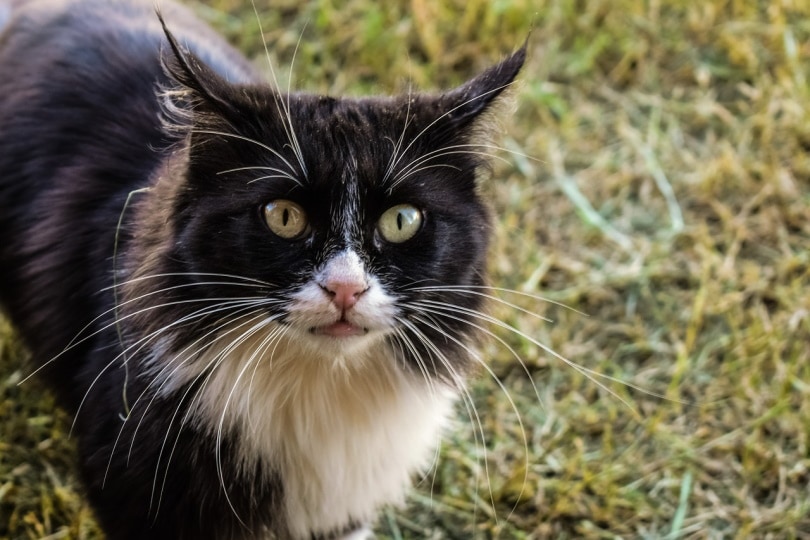
Have you ever wondered if feral cats can purr? It’s a common question that often goes unanswered. But the truth may surprise you. While feral cats may seem wild and untamed, they still possess many of the same traits and behaviors as their domesticated counterparts. This includes the ability to purr. In fact, purring is not just a sign of contentment for cats, but also a way to communicate and self-soothe.
But how do feral cats, who are often wary of humans, use their purring abilities in the wild? And what can we learn about their behavior from this unique characteristic? In this article, we’ll delve into the surprising truth about feral cats and their ability to purr, and explore the fascinating world of these often mysterious creatures.
Feral Cats and Purring
Why do cats purr? Many people associate purring with positive social situations, such as nursing, grooming, and relaxing. Feral cats are less likely to purr than domestic cats, and experts believe that it’s because they’re mothers don’t purr or encourage it as it may cause them to attract predators. However, this doesn’t necessarily mean that feral cats can’t purr. If feral cats are domesticated and made to feel safe, they may in fact purr. But purring may be more soothing or self-soothing, and cats (including feral ones) can also purr when they are stressed as a way to try to calm themselves down.

Guide for Taming Feral Cats
Yes, believe it or not you can tame feral cats. Note that a feral cat won’t be able to become friendly or behave like a normal house cat, necessarily. But you can teach them to be less aggressive and more responsive. This is especially true if it’s older. You can make the feral cat happier and healthier. And if you want to try taming a feral cat, here are the steps to take.
1. Capture the Cat
Before you can attempt to control the cat, you will need to securely capture them. This will allow you to transport them to the vet as well as within your home. This can be a bit of a time-consuming task, since feral cats are often very frightened of humans, even if they offer food.
To get to know your cat’s habits and hangouts, you will need to purchase a cat trap. And it’s best to place the trap in an area where the cat is most likely to be found, so set it anywhere that you see the cat hang out often. This can be under your porch, in your shed, or beneath your deck. The trap should be left unattended for several days.
2. Take the Cat to the Vet
Once the cat has been captured, it’s time to take it to the vet. Before you can start working with them, you’ll need to check the cat for the following:
It is best to contact your vet before you bring a feral cat in. As a precaution, note that some vets won’t accept feral cats. If the vet won’t take the cat, it’s best to just let it free. You don’t want to risk bringing any illnesses into your home, especially if you have other pets already.
3. Give the Feral Cat a Space in Your Home
After the cat is checked by the vet and given the okay, it can be brought inside your home. You should already have a safe place ready for your cat when you bring her home. The safe room should contain scratching posts, food, water toys, and a litterbox (make sure the litter and food are not on the same side). The room should be kept quiet and not intended for human use. It also helps to have small, safe hiding spots in this space, like a cat house, or a blanket over a chair. Don’t leave anything in there that may get knocked over easily and harm your cat.
You shouldn’t allow the feral cat to interact with other pets or family members initially, as it may still be a danger and it may be frightened of everyone in the house. So, it’s best to confine your cat to one room to ensure the safety of all of your family pets. Also, make sure they have easy access to clean water, food, and a litter box. Also, you may want to be prepared for the cat urinating around your home to mark territory. After all, it’s still a feral cat.

4. Don’t Force Physical Contact
When your cat feels secure, they’ll be more likely to come to you. You can give the cat a little bit of food or a treat. This will initiate contact with the cat and allow them to form positive associations with you. But don’t force it. The cat will initiate any contact that they’re comfortable with. It takes a lot to get semi-feral cats to approach you.
5. Use Food to Build Trust
You must establish positive relationships with humans to help your feral cat be tamed. Food is typically the best way to achieve this. You can also establish a routine and sense of safety by feeding the cat every day at the same time. This will help the cat get used to a schedule and make it more comfortable with both you and the environment. Never interrupt the cat while they’re eating their food, as this can typically provoke an aggressive response from the cat (like with dogs).
And for your safety, it’s important to keep your cat in a cage or kennel while you prepare the food. Feral cats aren’t socialized with humans and can become aggressive as they learn to trust you. Try talking to the cat while you’re in the room. Also, be sure to move slowly as you don’t want to startle the cat. Yes, it may seem odd at first, but cats learn to recognize humans by their voices. And talking with a cat can help it learn to recognize you and develop a familiarity and then a level of trust and comfort. Note that this will be the most difficult part of the entire process.

6. Avoid Eye Contact
Do not stare at your cat if they’re staring at you. Eye contact can be a sign of aggression for semi-feral and feral cats. If you’re caught in an eye contact situation, it’s best to blink slowly and calmly. For a few seconds, keep your eyes closed and look away. This will show your cat you’re not trying to harm them and that you are playing a submissive position. It helps them feel secure and confident in their new environment. Remember, these cats are used to protecting themselves from predators so the safer you make them feel the less likely they are to lash out aggressively.
7. Be Super Patient
The most important thing to remember when adopting a feral cat is patience. These things can take time and cats are known for being very protective and timid. So it’s crucial to allow them to have their space, until they feel comfortable. It may take longer than you expected, but they will soon feel safe in their new home.
Conclusion
Feral cats usually don’t purr, but that doesn’t mean that they can’t. They may purr if they’re feeling stressed or if you’ve brought them into your home and they become more comfortable with you. Before introducing a feral cat into your household or to other pets, make sure you get a professional opinion by a vet. They’ll be able to tell you if the cat is safe and free of diseases that may be spread to you and the other members of the house. They can also offer some guidance on how to help tame the animal so that it becomes more comfortable. Over time, with patience and a lot of nurturing, you can domesticate a feral cat in many instances, but it’s best to remember that these cats usually will never behave completely like a typical domesticated house cat and may just learn to coexist with you.
Featured Image Credit: ivabalk, Pixabay






